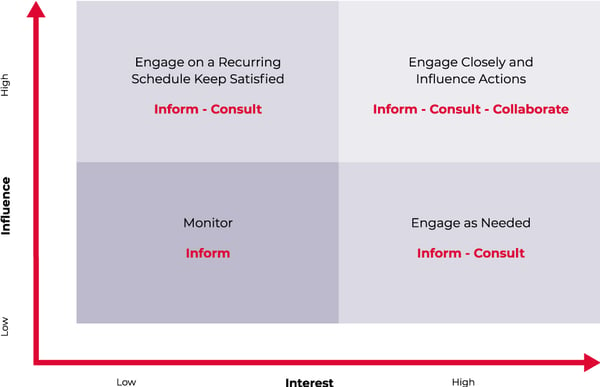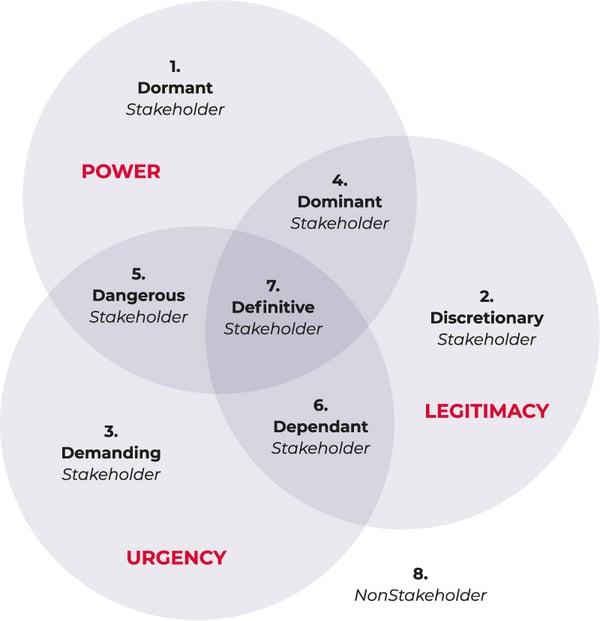Before you get started with your communications plan, you must go through the process of identifying and categorising stakeholders.
Why do you need to categorise your stakeholders? Simply, not all stakeholders are equal. And not all of them will require the same amount of attention.
Each stakeholder will have preferred methods of communication, and a strategy for stakeholder communication that recognises this is more economical and efficient.
Categorising stakeholders is one of the key steps in the stakeholder analysis process.
It is also used internally as a way to demonstrate how stakeholders should be managed and communicated with, which can be really helpful when you onboard new team members.
How to get started
The first step to categorising your stakeholders is to create a simple chart, based on the method you choose to classify them.
Whatever method you use, you are looking to use stakeholder mapping exercises to understand each stakeholder according to the criteria of influence/power capacity and interest level.
Below are two popular methods of stakeholder categorisation: the influence/interest matrix and the salience model.
They will help you obtain relevant insights about your stakeholders to inform your communications strategy.
How to use an interest/influence matrix
The interest/influence matrix is a powerful tool for identifying the weight and type of communication appropriate to each stakeholder and stakeholder group.
As you can see in the diagram below, the interest of the stakeholder is plotted along the ‘x’ axis, whilst the influence is plotted on the ‘y’ axis.
Attributing a stakeholder with a score from 1 to 10 for both these categories will provide a point to plot in one of four quadrants.
The communications strategy can then be informed by using the three levels of engagement (informing, consulting, and collaborating).
Using the three levels of engagement approach ensures that a suitable amount of engagement is provided to each quadrant and that each stakeholder group is satisfied.

Using the salience model
The salience model takes the concept of classifying stakeholders even further, with a Venn diagram of three parameters - urgency, power and legitimacy - used to segment eight stakeholder types:

Dimensions:
- Power is attributed to a stakeholder who has the ability to influence the project or its outcomes.
- Legitimacy is the level of involvement and interest a stakeholder has with the project.
- Urgency relates to the time that a stakeholder expects attention, responses and actions.
The eight stakeholder types:
1. Dormant: stakeholders who have power, but no levels of involvement or urgency and aren't likely to show interest in getting involved. As they can influence the project, it's best to manage closely.
2. Discretionary: stakeholders that have legitimate interests but have little influence or urgency. Despite the low power, must meet their needs as they have high legitimacy.
3. Demanding: those who require attention and want their needs addressed. They have no power but still can influence other stakeholders.
4. Dominant: these stakeholders have power and interest in the project and must be managed closely, but without urgency in mind.
5. Dangerous: stakeholders with influence and urgency that can represent problems and must be managed cautiously.
6. Dependant: those who have legitimate interest and demand urgency but have no power. Ideally, keep a watch as they can associate with influential stakeholders and cause damage.
7. Definitive: the category of stakeholders you must manage closely as they have influence, interest and urgency.
8. Non-stakeholders: this group has no influence, urgency or legitimacy, so you won't be managing them for your project.
A stakeholder identified as ‘dormant’ requires a more hands-off, informative approach, whilst a 'definitive' stakeholder needs a much more engaged approach, using collaborative and consultative tools on top of being kept informed.
The salience model allows a deeper understanding of each stakeholder’s needs, and when used correctly can better inform the communications strategy and the digital tools you need to use.
Project areas of influence
A geographical approach can also be helpful to categorise your stakeholders based on their proximity to your project.
Separate the geographical areas into four zones:
Zone 1: Major
Zone one is the closest to the project site. These interactions/impacts on stakeholders will be on a widespread basis (such as daily).
Zone 2: Moderate
Zone 2 stakeholders frequently deal with the project (interactions/impacts). These aren’t as specific as zone 1, but still important.
Zone 3: Minor
In zone 3, a stakeholder interaction with your project will be limited in time and potentially restricted to a specific phase of the project.
Zone 4: Negligible
Interactions could occur on an incidental or occasional basis with stakeholders in this zone, and impacts are either very limited or inexistent.
Thorough stakeholder analysis and categorisation will ensure you've identified more specific stakeholder types, such as vulnerable people including ethnic minorities, the elderly, the disabled and more.
We hope this has brought clarity around some of the key areas to look at before you start your community engagement and why categorising stakeholders is so critical.
The next steps
A stakeholder management software that’s fit for purpose allows you to easily categorise and track your stakeholders over time with our analysis and mapping tools.
Your stakeholders won’t stay in these groups forever and using Excel spreadsheets or your CRM system won’t cut it.
You need a proper stakeholder management system if you want to successfully engage with your stakeholders and deliver better results.
Talk to us today to learn how Tractivity can help you improve your stakeholder engagement.

